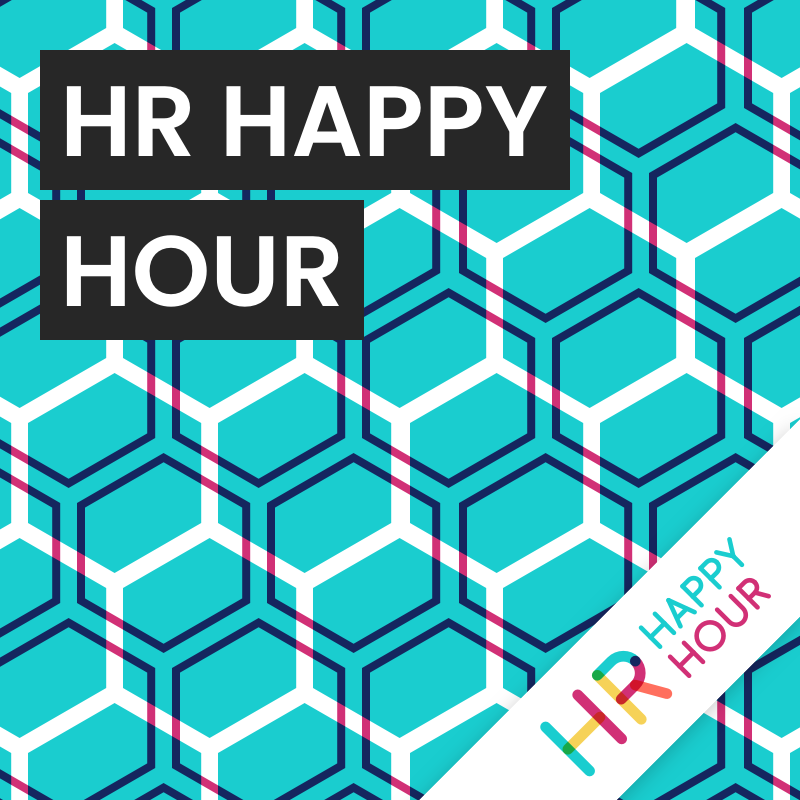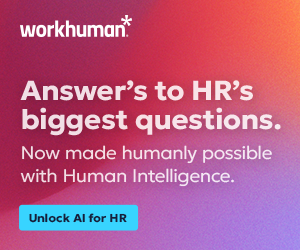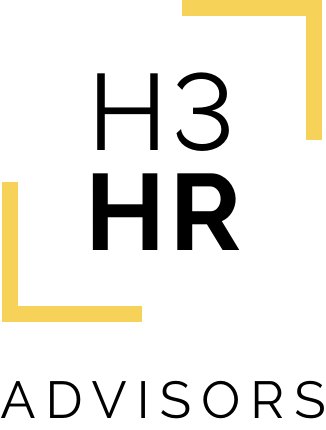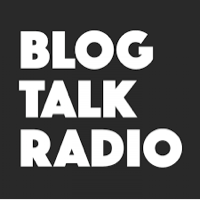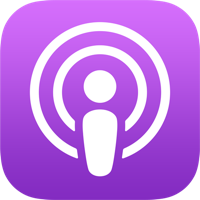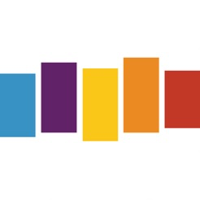HR Happy Hour 489 – Work Reimagined with EY
Hosted by

Steve Boese
Co-Founder and Chief Data Officer of H3 HR Advisors and Program Chair, HR Technology Conference

Trish Steed
Co- Founder and Chief Strategy Officer, H3 HR Advisors
About this episode
This week we were joined by Jonathan Sears, Partner in the People Advisory Services and Ros Feinsod, Principal at Ernst & Young LLC to talk about the highlights of the Work Reimagined Survey, such as job satisfaction, flexibility at work, and how company culture has improved during the last year. We discussed the importance of transitioning to a more hybrid work model and how to ensure collaboration between in-person and remote employees. We also talked about the right pace of return to work changes and how to measure productivity with remote workers. Lastly, we covered the importance of addressing wellbeing with your workforce.
This was a great show. Thank you Ros and Jonathan, for joining us! Remember to subscribe to the HR Happy Hour wherever you get your podcasts.
Transcript follows:
Steve 0:00
Welcome to the HR Happy Hour Show with Steve and Trish. Trish, if you decide to retire, just give up the corporate life give up the lifestyle, all the fame all the glory if you just decide to walk away tomorrow and open a food truck, Trish, what are you serving?
Trish 0:16
That is a tough question, but a good question. I don’t know why this popped in my head. But doughnuts. I’m not even a doughnut person. Like literally when you said that so I guess a doughnut truck.
Steve 0:28
Yeah, that’s a good answer. I would have not thought that but I like it. I would be a customer of a donut shop. That’s for sure.
Trish 0:35
You know what I would like now that I think about just like small donuts, tiny donuts. Little like, two bite donuts. That’s that’s my food truck. The two bite donut truck.
Steve 0:45
That’s good already. I’m gonna steal that, some listeners gonna steal that idea. I probably will not do that. But it might get stolen. Trish, if the two bite donut truck shows up somewhere. You’ll know that was your idea.
Trish 1:00
The two bite donut truck.
Steve 1:02
Listeners all over the world, someone’s gonna pick that up. Great answer, I like it.
Trish 1:07
Steve maybe this is how all great businesses start. You have to just like right, it’s like sort of like write it on a napkin? Yeah, you just have to ask someone a question. And boom, that’s it. So what about you? What’s your food truck?
Steve 1:19
It’s over done? And I probably would not, I struggle with the competition because there’s so many of them. The only thing I know how to cook is barbecue. That’s it.
Trish 1:26
I knew you’d say that.
Steve 1:27
I don’t know how to cook anything else. But I think I would do a spin like on sausages and hot dogs probably specifically, I’m not sure like the big slow roasted giant cuts of meat and we’re going to work on a food truck. They take way too long to cook like you have to spend all night cooking them to sell them the next day. It’d be rough lifestyle. So I’m going brats and sausages.
Trish 1:46
We’ll have to ask our guests when they come on, you would have so they hopefully they’re thinking about it as they wait in the wings here.
Steve 1:52
I think one of them is going to say two bite donut truck. So we are going to talk about returning to work hybrid workplaces. Lots of the issues that are coming up in organizations all over the world, kind of making this adjustment to slowly getting back to normal. There’s tons of issues. tons of things for HR folks who listen to this show need to be thinking about we’re excited to welcome two folks from Ernst and Young who are going to talk about that with us. Before we welcome them Trish, let’s thank our sponsor Paychex. Of course, this episode of the HR Happy Hour sponsored by Paychex one of the leading providers of HR, payroll, retirement and Insurance Solutions for businesses of all sizes. More than half of business owners with 10 to 500 employees, they the availability of the COVID-19 vaccine is causing them to start or start planning their return to the workplace good topic because that’s what we’re talking about today. If you’re thinking about instituting a policy around vaccinations, we encourage you to download Paychex latest ebook, managing COVID-19 vaccinations and the return to work to learn about key considerations for developing your policy as well as important health and safety measures. for establishing a safe and productive return to work. You can go to payx.me slash ebook dash vaccines, and this link will be in the show notes. To download your copy of the ebook today. Big Issue Trish, huge issue with vaccines. And there’s a lot of other issues when returning the work vaccines is one of them. We should give one about the NFL player just on a rampage about I’m not getting vaccinated and I don’t care what anybody says. I mean, that’s a high profile one that we’ve heard about, but I’m sure there’s lots more of that going on in the corporate world. But you don’t want to hear me talk about that judge.
Steve 3:30
We have guests who are going to help us navigate some of these issues we want to welcome first Jonathan Sears. Jonathan is a partner in the people advisory services practice of Ernst and Young. He the seasoned executive with broad international and domestic experience, and demonstrated success delivering business value for industry leading companies. His diverse technology experience includes end to end ERP and HCM projects as well. We love that, as well as cloud based technologies focused on organization and workforce transformation, change management, learning culture, leadership and employee experience. Today, Jonathan spends much of his time working to help organizations bring digital solutions, automation and emerging tech to solve a myriad of workforce issues. Jonathan, welcome to the HR Happy Hour Show. How are you?
Jonathan Sears 4:15
I’m doing great, Steve and Trish. Thanks for having me.
Trish 4:18
I have to tell you, we’re so excited to have both of our guests on today. But if I were a younger person just entering into the work world, and had the opportunity to work with someone like you, Jonathan, who has that as your bio, like I would have been all over that. That would have been like my dream, like leader to work with. So yeah, quite accomplished.
Jonathan Sears 4:37
That’s great. I really appreciate that. And my dream is to own a two bite donut truck so we’re already out. It’s great.
Steve 4:47
Before we get too far down to the donut truck hole, let’s welcome also our other guests Ros Feinsod. She is a principal at EY and the principal in the people advisory services consulting on transformation and transactions. She has been a key contributor to thought leadership about COVID COVID-19 pandemic and is supporting companies with trusted transition to the office and reimagining work. She has extensive experience consulting for Fortune 500 companies on workforce planning and strategy and labor cost review. Ros holds a BS in actuarial science. Those are the funnest people, the actuaries. I’ve always heard that from St. John’s University and is a fellow of the Society of actuaries. Ros, welcome to the HR happy hour show.
Ros Feinsod 5:26
Thank you, Steve and Trish, great to be here. And hopefully you’ll see how fun the actuaries can be with lots of analytics about returning to office.
Steve 5:33
I’m not even kidding. Because you’d see these surveys that would come out, I don’t know who would do them. But like, periodically, you’d see over the years, what’s the best job to have, like, you know, on a variety and besides labor, you know, besides like relief pitcher for the Mets, which would was the job I always wanted and couldn’t get actuary would always be like number one, as like the best job like a normal person could have.
Ros Feinsod 5:56
It has been for many years. Yes.
Trish 5:58
We’re gonna dig in on our topic. But for some of the listeners who I know, we’ve got a lot of people who are sort of Gen X who have kids where they’re teenagers going to college, can you give us like quick, like, down low on what is an actuary? What kind of background like, how did you get into that, I’m just curious for the listeners.
Ros Feinsod 6:14
An actuary is someone that consults on risk, and uses all kinds of statistical methods to help companies make better decisions about anything they’re taking on. So that could be their retirement plans, their health care plans, or more broadly, any kind of risks that they’re assuming as a business?
Trish 6:31
Good, because I think a lot of times we think of it only in terms of like insurance. So it’s good to hear that there are many, many other ways that being an actuary can be applied in the sort of in the real world for jobs, I know that, again, a lot of got a lot of teens and young, young 20s, who listen to the show as well. So that’s always good for them to hear about different jobs. Thank you.
Steve 6:50
Alright, let’s start with this. I’d like to start here. Well, we’re sort of we’re recording this in late June, right organizations around the world, certainly here in the US where we’re recording are slowly getting back to quote unquote, normal, or maybe many, some many, some have already gotten back. But there’s tons of issues right with sort of coming back out of 15 plus months of just disruption and stress. And you know, all the things that have happened organizations, you I did a really big survey called the work reimagined survey about 16,000 employees to get to get a pulse of what people out there are thinking about some of these issues about returning to work and what, what what organizations and workplaces need to do going forward to thrive, maybe jawsaw 30? What are some of the just the big, big picture, the big highlights that you guys are finding either through the survey data or with your client work that says these are the things organizations are wrestling with right now? Here’s what’s like top of mind for HR leaders today?
Jonathan Sears 7:44
Sure, no, I think one of the biggest findings from the survey is that overall employees have still a high degree of job satisfaction. And I think that comes from the place where employers have done a pretty good job of navigating the last 15 months, they feel like they’ve been there to support the workforce employers have flexed in the ways that they needed to flex to ensure that that that employees felt both safe and secure if they had to come back to the office, but also had the right tools and enablers to be successful if they were now working virtually or remote for the first time. I think the challenge for employers will be going forward, we saw a high majority, about 54% of respondents said if new ways of working are not adopted, if we are not given flexibility in when and where we work now that we’ve proven that we can actually do things better different, more efficiently, that that’s going to be a attrition driver, right. And so we’re going to start to see people potentially leave the workforce, potentially a new war on talent. And potentially companies needing to rethink benefit plans and how to really attract these folks that might not be as tied to a single location or a single region, as they have been historically. And so we’re already seeing that in some sectors, I think you’ve seen a few media announcements from CEOs that are asking folks to come back to the office and in other sectors, the CEOs are saying we’re going to try to stay full time virtual full time, you know, away from the office. The answer is we don’t really know yet. And I think we’re going to be sort of watching the next 12 months as companies test out a number of hybrid methods and a number of solutions for different types of workers and different classes of workers to ensure that they’re responding to the needs of the employees while also still running a very sort of strong and balanced business going forward.
Ros Feinsod 9:38
Just building on that. I think one of the most interesting and surprising findings is that nearly half of employees say that their company culture has improved during the pandemic. And you sort of scratch your head and say, How is that possible? We haven’t been together. We don’t know how tall people are that we might be working with for the first time. But yet at the same time, you know, we have put people at center we’ve given them all the flexibility that we possibly humanly can, we’ve gotten to know their pets and their children on different calls that we’ve encountered with them. And to some degree, we equalize things a lot, we’re all the same box on a screen. And we’re not defined by our fancy office with a couch and a table. So I think there has been a lot about culture that really has improved on top of the piece of decision making where we might have been slow to move forward. And now all of a sudden, we’ve had to rethink everything that we do as a business and people like that pace.
Trish 10:27
You know, that is a great point, actually, both of you, but Ros, specifically, kind of building a question around what you just said, you know, do you think that, you know, for many years, my career 20 plus years, we’ve been talking about, you know, what we can do to improve culture, what we can do to build that connection? Right. And, and all the things that companies were trying really didn’t make that big of a dent that big of an impact. Do you think that? Obviously, we don’t want a pandemic? But do you think that this was really kind of the shock that companies needed to be able to have an opportunity to step up? Because I almost, I wonder if that’s the case, like we needed some big, big catastrophe that would really like kind of impact everyone to sort of normalize and level that playing field? Is that what you’re kind of seeing then?
Ros Feinsod 11:13
Yeah, I think it has been a wake up to more specifically defined culture, because in certain ways, we might have always been comfortable that culture is about our values. And this is our secret sauce. And we can’t really explain what it is. And now that we’re not together, and it’s not defined in the same way, and we’re working with people all around the world and in virtual teams, we really have to define what are the behaviors? What are the things we need to keep from our past culture that was bid, but what are the new things we have to start and we have to really stop doing in order to accelerate our culture, whether that’s things around talent recognition, and our focus on people, whether it’s how quickly you make change, or how we trust and empower the people in our organization.
Steve 11:51
Jonathan, there’s an interesting data point I wanted to ask you about from the survey, which is pretty clear to me. Nine out of 10 of employees want flexibility in where and when they work nine out of 10 that’s kind of like everybody, right? Especially in least in America, right? If you can get five out of 10, to agree on something, you’re doing anything, honestly, you’re doing pretty good. Nine out of 10. And so with that sentiment out there, right, I wonder if you could comment a little bit about either some of the announcements we’ve seen publicly, or maybe just without naming names necessarily about some of the organizations you’re advising about this idea of transitioning back to some sort of a hybrid model, because I’m reading the nine out of 10 may be very, very wide one way meaning I want that flexibility myself, Steve, the employee I want to choose. And we’ve seen a lot of announcements in the apple one, just name one name, right, that said, we would like everybody to start coming back. And on these three days, Monday, Tuesday, Thursday, which to me is not super flexible, that’s just the employer giving me a different schedule than I used to have before. So I’d love your thoughts on how organizations are moving to this new thing, and maybe some ideas about how they can sort of be better at it maybe and sort of give the employees what they’re looking for while also serving the needs of the business.
Jonathan Sears 13:09
It’s important to remember that our survey was 16,000 employees in 16 countries around the world. So it is the view of the worker, it’s a view of the employee. And clearly, they’re asking for flexibility. But some of the companies are clearly not taking a position of flexibility at the level of which employees would want that doesn’t mean that they’re not going to move in some direction and offer something. But you have to remember, we spent the last 100 years being very successful working together in the same location and a place where work was defined as an activity, then we spent the last 15 months being really successful, being sort of everywhere, in anywhere, in some cases, picking up and moving across state borders, or country borders to be with family, you know, being disconnected from our home office. And we had technology like we’re using right now to effectively connect with people and have important conversations.
Jonathan Sears 14:02
Now we’re going to go back to a world where companies have to solve for what happens when some individuals remain virtual and remain remote. And some individuals choose to come back to the office, and how do you ensure that if it’s a team of six people and three are at home and three are in the office, that they can collaborate effectively together, that they can have productive dialogue, and that there’s not a disadvantage to those that are virtual. We all know we sit in a meeting room together in person when the meeting ends. chatter still happens. There’s still discussions there’s still dialogue is brainstorming. Well, if you’ve already turned off the zoom call, the team’s call, those three individuals at home are losing the ability to connect and dialogue. As part of the ongoing engagement that will be a significant challenge for companies to have the right technology, the right processes, performance management processes, rewards processes, to ensure that we don’t end up with a two caste system, those that are in the office, and those that aren’t. And so I think the way companies are approach to get hopefully, is they’re looking at work activity. And they’re not looking at broad brush, peanut butter spread policies, they’re saying, for these types of jobs doing this kind of work, it makes sense that these can be done virtually successfully 80% of the time, or 90% of the time. And for these sorts of jobs, we want them to be in the office, because here’s the value to both you as an employee, and us as an employer, and to do so this is how we’re going to flex on both sides of that here are some compensation changes, here are some benefit changes to make sure that we are sort of making a really strong employee employee value proposition, whether you’re one of the folks who are virtual, whether you’re one of the folks that are in the office.
Trish 15:43
Yeah, I think that’s a great point, Jonathan, I think to one of the things that companies and HR leaders specifically need to be thinking about is, you know, we had to rush into everyone working from home, we don’t have to rush and make this decision overnight. And I think that when I talked to a lot of different leaders, they’re feeling like they’re being very rushed in making that that decision. I’d love to hear Ros or Jonathan, kind of your take on that. Like, what? What should the pace be based on kind of just your experience with lots of different organizations? Like, what’s a good pace? If I’m an HR leader? to thinking like, yes, we need to make some of these changes, and whether that’s hybrid or not, or whatever we decide? Should it be? Should we feel like, Oh, my gosh, we’ve got to do it right now? Where we’re gonna lose people? Or is it okay to take a little bit of time? Like, what what are your feelings on that? And that could go to Ros or Jonathan.
Ros Feinsod 16:36
Yeah. So there definitely is a need to say something because employees are waiting to hear something right? over 150 companies, we’ve been monitoring these announcements from different companies. And so over 150, companies out there have made announcements of where they stand on this point. And so your people are waiting to hear. Now, does that mean that you have to jump to a permanent version of some specific model hybrid? Absolutely not. And we hear many companies announcing things around. This is an adjusted adopt phase, we’re going to experiment and learn this is about continuous change. And so really, companies are positioning some period of time as learning time to really see how this evolved. And to really assemble the best data, whether that’s employee preference, whether it’s the utilization of facilities, and continuing to explore technologies, they’re going to really support this going forward. Thank you,
Steve 17:29
Ros and Jonathan, either of you. Maybe I’ll throw it to Jonathan. And then Ros can comment later. Would you caution companies right now, if you were advising a client say about sort of choosing one or the other extreme, for example, like we’ve talked like, there are some companies out there, we know, some of the financial services companies are doing this, banks, etc. Maybe some others saying I want everybody’s coming back in as soon as we can, as soon as it’s quote unquote, safe. Everybody’s coming back in back to how it was in 2019. Right. And then on the other end, there are some companies, some famous ones as well, that we know who said, you know, what, we’re just remote. That’s how that’s it, you know, work wherever you want forever and ever. The other extreme are? I’m worried about companies doing either of those, because it feels like it gives you no, no wiggle room for something in between. Or as you may be surprised, like, we’ve got to kind of figure this out a little bit. So would you maybe, what would you say to companies who were maybe thinking about coming on one of one of either of those two ends of the barbell right now?
Jonathan Sears 18:31
Yeah, I think the point that Ros just made is a really good one, right? It’s important to have communications with your employees, they need to understand what you’re thinking. But, Steve, to your point, the extremes right now are not a permanent place to live, right. And so, if we think back to March of last year, when the pandemic was sort of at its height, at least in the US market, we really didn’t know what was going to happen. But by June or July, we saw CEOs act to actively saying, this is great, we’re gonna save a ton of cost on real estate, we’re not going to come back to the office, that was like the invoke thing at the time, fast forward to February, March of this year. And all of a sudden, CEOs are saying, let’s get right back to the office, it has to go back to the way things were. And so we’ve already seen many companies start on one extreme and shift back to the other extreme, which is why sitting at either place right now is not the right answer. It’s sort of sitting in the middle. It’s understanding your workforce, understanding your business needs, understanding what’s going to continue to attract the right, attention and talent, it’s very easy to assume that employees will all want remote and virtual. We also know from our survey, that that’s not the case, there’s still a large percentage of folks that do want to get back to the office. And so even going so extreme to say, we’re going to give you all this flex and you can be virtual remote as much as you want. We’re not going to encourage folks to come back together that could also disenfranchise a significant part of the workforce. And so having balanced to your approach and making sure you’re dialoguing with your workforce about that as important.
Ros Feinsod 19:59
The other thing Two is that it’s not a one size fits all, even for a given organization. So, if you take someone that’s on a trading floor, I mean, there’s absolutely a case to say that there’s an energy and momentum element that you need those people together. And from a compliance perspective, it’s complicated if they’re not in the same place. Take another example, though, if you have call center folks, there is not one employer, I have spoken to anywhere in the world, who has not reported that their call centers have had off the charts numbers through the pandemic, and that is the most measurable you’re recording your calls being recorded for quality assurance purposes, you know, your customer satisfaction, your first call resolution, we know everything about you. There’s not one call center. So you know, for ones like that, do you really want to take space in a building and force all the call center people to sit in one place anymore? I’m not sure. So I do think that on some job families, there might be a second to that approach that you’d say, we know, some clear answers and data in some jobs, that it makes sense for them to be together in other jobs where they can be truly virtual.
Trish 20:58
I love that. And I think the call center is a great example. Right? And there are other jobs like that where actually sometimes productivity goes down when you are seated next to others who are trying to do a similar job that aren’t directly involved in what you’re doing. Right? If especially if you’re dealing with customers, right? You don’t necessarily need all that back and forth between the employees. Now, again, they might miss the water cooler talk or you know, in the lunch room, that sort of thing. So you might have a little dip there. But I wonder, too, is this really HR and just senior leadership’s opportunity to rethink productivity? I know, at Ernst and Young That’s right. For for many decades, that’s been, you know, productivity, new utilization has been very important measures. Are you hearing I guess, it’s very early. So you may not have anything on this yet. But are you hearing that there are companies that are really feeling good about the productivity numbers, they have maybe even beyond call centers, for example, like, like professional services, even at Ernst and Young? What are you all seeing and hearing?
Ros Feinsod 22:00
I think some companies and jobs are feeling really good. And some companies and jobs are feeling uncomfortable? In terms of where are they at with the ability to measure productivity? Now, honestly, did they really have a good measure of productivity? Because they saw someone’s late on early and they saw them in the parking lot? Or they saw the light on late? Did that really mean that they were productive at what they did? No. But it still was a false sense of comfort. So I think what companies are truly learning is that where they didn’t have a sense of productivity, the pandemic fundamentally didn’t really change that. And you have to learn what are the core measures for some roles. And it’s very easy in some roles, professional services, as you shared, we bill our hours into a time system in quarterly increments. And so we know exactly who is working and what they’re working on around the world and where they’re working. But for some organizations, that’s more of a challenge where they don’t have that easy ability to know how people are spending time. And so therefore, there’s a lot of technology that companies are looking at, to try to get a better sense of utilization, and how do we really deploy work in a better way where we had a better sense of that, intuitively. Now, we have to plan our projects and manage our work differently.
Jonathan Sears 23:05
But I think companies too, are struggling with talking about measuring productivity, because I think from an employee perspective, that feels a little big, brother ish, right? And so is it about how do we measure collaboration? How do we measure engagement? How do we measure efficiency? I do think companies have the right tools to do so. And one of the data points from our survey, which affirmed that is two thirds of respondents said that they felt like their job, even when virtual can be measured effectively by their employer. And so that, that that productivity connection, is I think, well understood by both the employer and the employee.
Trish 23:41
And yeah, I think it’s more about results, right? I mean, it sort of forces that if you can’t see everyone, you have to really just look at the work results to see have they been productive or not? I wonder too, though, as on the employee side. And, you know, you mentioned earlier that there are a number of people in the survey who said they want to go back to a workplace, right? They want they actually thrive, maybe in a more structured environment, or they like, more direction, right? Or they feel maybe opportunities are there. I wonder if Are you getting a sense of those employees that that need that? Are they going to feel? I don’t know, almost at a disadvantage long term. Going back, though? I don’t know. I’m kind of like thinking about both sides. Right. We’ve talked a little bit about maybe if you’re at home, you’re not having that connection. But I wonder too, if you’re in the office, maybe you lose out on some amount of creativity, or, you know, is that flexibility that they’ve had for the last, you know, 12 to 18 months is, is that going to go away? If they go back to an office? I don’t know. Are you getting a sense of sort of the other direction of the of the results? Is there a negative going back?
Jonathan Sears 24:50
I think the important point here is, at least in our survey, there’s three main personas that are really driving this. So we call them office optimal, which are the folks that want to get back home. hopefuls that want to sort of live in that flex environment. And then remote ready folks that want to be full time remote or at least feel for four days a week. And where you are at any given time in your life journey will determine which of those three personas you own, you’re never going to be one and stay one for the next 30 years. It’s and, and everything in our data shows that those that are more office optimal are later in their tenure with their employers, and everyone that is remote ready tends to be the gen Z’s and the millennials, right. And so, you know, probably no big surprise to you guys or to your listeners. But I think it’s important to remember that, you know, Ross made the point earlier about, you can’t have a one size fits all strategy, that that’s forever, that’s for everything. Now, you may need to have multiple benefit plans and programs, multiple pay structures, and you might be comfortable, have to be comfortable being fluid, and allowing people to say right now in this job today, I’m office optimal. But two years from now in my next job, I might need to be remote ready, your hybrid hopeful. So people will move across personas, and companies need to be able to respond to any mix of those.
Ros Feinsod 26:08
I was going to also say that geographically there are some differences. Absolutely. So if you look at in Asia pac, for example, there is definitely a larger group of office optimales. Because people just don’t have the larger living spaces, and they want to be in the office. And culturally, they want to go out to lunch with their colleagues. So there’s absolutely globally culturally not a one size fits all model. And to Jonathan’s point, it’s really about making sure that whichever category you’re in, you have equal opportunities for participation and and maximizing your work on a daily basis, as well as for your growth and career progression.
Steve 26:40
That’s really interesting point, guys, because I think I was about to ask a similar question. But Jonathan, you kind of laid it out slightly differently. We did a lot of mental health shows in these last six months, right on from with a variety of guests, you’re talking about lots of the mental health issues in around the workplace, that have arisen during the pandemic. And one of the things we saw fairly consistently, in the data that we looked at in the shows that we did was the mental health, the adverse mental health impacts were not the same across the workforce, they actually were tended to be a little bit more extreme or acute. In younger generations, newer workers right and for and there are reasons why that you could bet that happened. But I wonder if some of this filters into a to that like, like, there’s a lot of concern that you hear in some of these announcements, especially the return the return to work people announcements, talk a lot about a culture ideation and onboarding and informal learning, etc. But they’re largely focused on the newer workers. I think, like the folks who’ve been around for 25 years, they in an organization don’t really need that so much, right? They’ve kind of settled in, is that something that either the data showed in the survey, or maybe didn’t, or something you’re seeing as you talk to organizations and clients about about how to navigate these transitions?
Jonathan Sears 28:01
So I’ll go first. So I think from a wellbeing perspective, it is absolutely a focus of a number of employers right now. And it really should be all employers to ensure that both their training their line managers to identify mental health issues that may be there that employers are not self reporting, but also that they’re coming back to the office in a way that creates confidence in their workforce, that they can come back to the office safely, securely, and with the right support structure around them to be successful. I think, you know, if I think back to last year, really, all the work that we we saw in that sort of, you know, April to August timeframe, it was around, getting back to the office safely and securely, which had a big component around employee safety and well being associated with it. Everything that we’re seeing now is how do we reimagine work going forward? How do we think about new ways of working to be successful, but yet, employee well being is still so centered in all of that, because everyone to your point, Steve is going to have a different set of needs. They’re going to, I think we’re going to see things evolve, where it might be our younger generation that wants to or has to deal with this in new and different ways than maybe someone who’s worked for 20 or 25 years. I can’t imagine, you know, your first year in the workforce, or first two years in the workforce going through a pandemic like this. I mean, I think we all work through some pretty, you know, at the time felt like world shattering events, whether it was 911, or whether it was the real estate crash in 2008. You know, for you know, our new campus hires. It just started with us in January. I can’t imagine they’ve never been in an office, they’ve never met somebody else from from the firm. It is definitely something that has to be addressed and has to be front and center with employers.
Trish 29:55
Yeah, that’s an amazing point that a lot of us I think aren’t thinking of yet right is what about those Those people just entering the workforce, I wonder if it long term to that might even be an opportunity for them. Right? If you start out your career in such a drastically different way than people had worked in the past, I don’t know, will that make them more open to creative ways of working once they become leaders? Right at the future, we won’t know for quite a while. But I wonder like just being, you know, I’m 50. And I actually spent my first 10 years of my career at PwC. So very similar, right environment, and it was definitely about having your butt in that seat at a certain time. And if you left, you had to have your coat on the chair, right, like, so someone would think you’re there. I wonder if that though, as a as a worker, as a leader, as someone now who’s my age? Am I more closed off to more creative approaches to work than maybe someone who’s starting out now? Will they in turn be better leaders? I don’t know. Any, any thoughts? I mean, Ros, so you’re gonna predict them? Right? You’re reimagining. So what do you think on that? Will they be better leaders than we are?
Ros Feinsod 31:02
I don’t know. in a certain way, I think they will be because I think that agility that they have gained through this. And I think there has been just a huge amount of innovation that actually is going to carry forward into how we do things in the future. So I mean, when you think about companies had to onboard intern in classes, who never got to meet each other, and on the one hand, that was really tough. On the other hand, we’ve seen companies do some really creative things around some of the virtual environments where they could chat with a tech assist in any time where they can play scavenger hunts, and meet people digitally. And to some degree, they actually may be meeting more people than they might have had, they just walked around the single office. And a lot of people might have been away at client sites or on vacation or not around with your door closed. And sometimes we were purposeful now about who we’re meeting with, and taking the time. And to some degree, I think those interns and some of those early career, folks, there are benefits to their experience as well, because it’s with more intention.
Trish 31:57
Yeah, I agree. I think too, it also shows like one of you mentioned at the top here, where you know, we’re seeing each other at home, right. And so if I think back to working with a partner, or really any in any job, right, a boss who’s several levels above you, sometimes you put them on a pedestal and you don’t really think of them as, as human. Right. I remember early on in my career, one of the partners I worked with, you know, something came up and I was kind of coaching him, and I was very young. And he’s I’m just a guy, you know, and like that stuck with me. Because now maybe, I mean, you still want to respect obviously, people who have, you know, worked their way up in a company, but maybe that is good that you sort of see them as a person. They have a family, they have pets, they have whatever, right. So I think maybe you’re right, I think it’ll, it’ll be a benefit to these workers later on as they progress in their careers.
Steve 32:48
Yeah, good stuff. Last thing for me, guys. We’re gonna put a link to the work reimagined survey in the show notes. Of course, I encourage people to check it out. It’s really well done. It’s really, really interesting. It does sort of validate some of the things I kind of thought I knew or thought I thought maybe but I’d love for you maybe to tell our audience like if there’s any, just one last piece of advice you want to give them if they’re in the process. Now, I’ll give you an example. How about this, I’ll give you a specific example from a company I won’t name but I was talking to someone from a pretty big company are a very successful company who’s who did great through the pandemic for reasons that we don’t need to really get into but they’re their business thrive right? By the end, they’re all remote, right? It’s a it’s a technical company, right? So they don’t have frontline workers and storage like that. They did wonderfully, right? They just happened to now they’re dragging everybody back to the office starting really soon. And this person told me as an HR person told me, they’re already having retention issues, it’s already starting. So what would be besides sort of tell you tell the CEO to change their mind, which maybe is the advice, but let’s say you can’t give that advice or the CEO? Is that taking that advice? Is there any advice you might give an HR leader in that situation? Because I have a feeling there’s a lot of them out there, there will be a good number of them out there dealing with some of these issues?
Jonathan Sears 34:04
Yeah, I think you have to have a really strong employee listening strategy. So you have to know your workforce, and you have to understand what their sentiment is. So that you’re ahead of any potential attrition risks that may occur. I also think it’s very easy for companies to zero in on one component of this, they’ll look, they’ll say, we want to protect and advance our culture, or we want to measure productivity, or we want to think about new ways of working and continuous change. And the reality is, the companies that are successful at this will be successful, because they address people components, they address technology components, and they address real estate, sort of issues and opponents. And if you can solve all three of those pieces, and you can understand that some of these issues you’re trying to solve will have dependencies on all three of those. I think those are gonna be the companies that we quickest to win. That doesn’t mean that everyone won’t win long term and three to four years. But if you’re talking about those companies that are going to be on the best way The worklist in 2022, and 2023 is going to be because they solve that challenge and their workforce really responds to it.
Steve 35:07
Ros, any parting advice for this fictional, not really fictional, real HR person who we’ve not named.
Ros Feinsod 35:14
And I think just continue to monitor the data and build the case for change, right? And that it’s not going to be a one size fits all. And you’re maybe a strong case for that return absolutely makes sense for some segments of the workforce. But let’s not apply that universally across the entire workforce. And let’s look for the data that supports, you know, for each group, what is really the right solution?
Steve 35:34
I love it. That’s great advice. Actually, I wish I would have given the person that advice, which I failed to.
Trish 35:40
Steve, I was gonna add to as well, I think that it’s fair to you know, if I’m the HR leader, I would try and find a way to, with some finesse go back to that CEO, or whoever the decision making team is and sort of say, you know, we’re trying to go back to a culture that we had 18 months ago, that is no longer our culture. So just kind of pointing out the obvious sometimes, if you do it in a very collaborative way might be all it really needs to kind of change the direction because again, a lot of companies were stuck in working in a certain way. And if they are seeing better success rates and things like that on a number of measurable friends, then sometimes just pointing that out is enough to at least get them talking about it.
Steve 36:25
Great, now I’ve got if I talk to this person again, I’m armed with better answers than I had earlier this week. So our last week whenever it was, alright, this is good stuff. We need to let our guests go cherish. They’ve been very gracious with their time with us today. Jonathan Sears and Ros Feinsod from EY, thank you so much for joining us. Great information. Great to get to talk to you guys today. And thank you so much for being a part of the HR Happy Hour Show.
Jonathan Sears 36:51
Happy to be here. Thank you.
Ros Feinsod 36:52
Thank you.
Steve 36:53
Awesome, good stuff. We will put links to the work reimagined survey in the show notes as well. Trish we must thank our friends at Paychex one last time, of course, check out their COVID-19 resources and all their resources at paychex.com. And Trish good stuff. I enjoyed it.
Trish 37:09
I did too. This is I mean, obviously we could talk forever about this. So you know, maybe we check in and six or nine months and sort of see if if some of these results from your survey are, are coming to fruition. And maybe you’ll have also some more insights to share with us of some, you know, case studies and real life examples, and we’ll see how Steve’s fictional non fictional HR person is doing in a few months. Yeah. Thank you both for coming on.
Steve 37:34
Thank you. All right. Great stuff. All right. Trish, get to work on the food truck recipes. And that is it.
Trish 37:39
Jonathan I are on it.
Steve 37:41
Oh, Jonathan’s roped in now. Okay. Thank you.
Trish 37:45
Yeah, he’s my partner.
Steve 37:47
Thanks so much for listening to HR Happy Hour Show. You can get all the show archives at HR Happy Hour dot net. That’s it. We will see you next time and bye.
Transcribed by https://otter.ai
Talk to us
If you want to know more about any aspect of HR Happy Hour Media Network, or if you want to find out more about a show topic, then get in touch.

